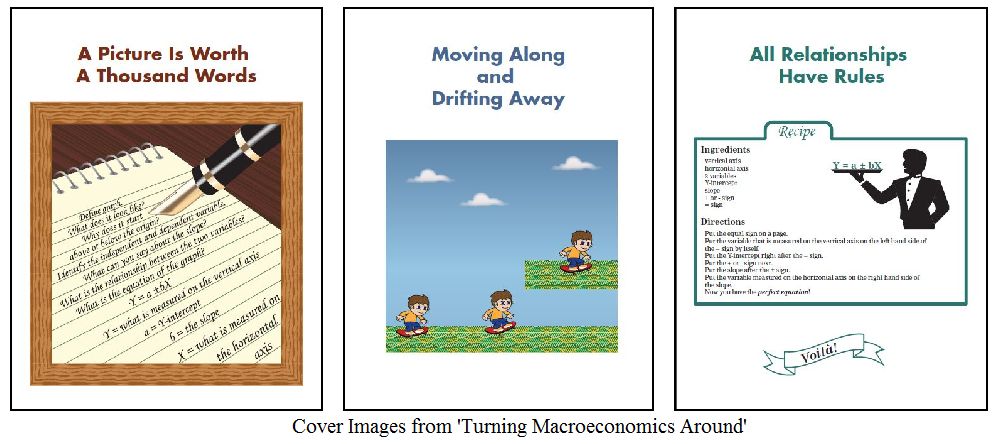Turning Macroeconomics Around
Recently, I noticed a drastic change in the student body. The Reform Students have completed their full cycle. Ten to twenty students were showing up for office hours every day. I was overwhelmed and forced to re-evaluate the type of students that I was teaching.
My students were missing reading and math skills required for the basic understanding of Macroeconomics. Many suffered from “graphobia” and equations were completely alien. They were not used to reading textbooks, and many were not even familiar with an index or table of contents. I noticed that they used pictures for call display on their cell phones rather than names. They watched YouTube videos rather than reading instructions on how to put things together. Some students only understood instructions when I said them as opposed to when they were written on paper. I observed that there was not much difference between the new student population and those that were traditionally considered to be a unique minority. Both groups of students were not processing information in standard, traditional ways, therefore, putting them at a serious disadvantage.
I began to reflect upon my career in economics. I could not forget where it all started; working with the Inuit in Northern Quebec. At that time, our Western concept of learning seemed to differ greatly from that of First Nations students. Upon reflection, I realized that First Nations students had a lot in common with the students I was currently teaching. They both learn by seeing, hearing and doing.
I always have had the philosophy that anyone can learn, if someone can figure out how they learn. My students were eager to learn and many of them felt ashamed that they were missing many needed skills. These non-traditional learners were more than willing to spend time outside class to acquire these skills. Many of them were visual and audio learners. Current textbooks put 12-15 words per line. The layout of the material along with the technical terms used, left the students overwhelmed. They did not know where to begin. I recently completed a course in Typography and Document Design, and I knew that if I could redesign the course material, it would be manageable and more meaningful for the students.

Covers in the documents that have been created to address this situation
Being passionate about economics, I applied for and received a grant from the Entente Canada-Quebec (ECQ) to create interactive multimedia modules for Macroeconomics that would be available for print, web, smartphones and tablets. These dynamic interactive modules will be tailored to newly emerging styles of information processing (seeing, hearing, doing). With the use of First Nations content, it will allow students to acquire the reading, math and analytical skills necessary to successfully complete Macroeconomics. These modules are also intended to help students become familiar with traditional books as they will have the appearance of a ‘real book’ with turning pages and navigation points such as indexes and table of contents.
All of the modules begin by listing objectives in a drawing of an iPad. The introductions provide an everyday example such as – Have you ever looked at a graph and wished that you could skip it? Then, there is an embedded inspirational video created by students who approach the problem from their viewpoint saying, We had problems with this and in some fun way, this is how we overcame obstacles.
These videos were produced by John Abbott College students as part of my ECQ project. Information is presented in a way that is pleasing to the eye, without compromising content. The summaries are presented as infographics since the amount of information that students retain in print is a lot less than they retain visually. They will surely remember texting from a drawing of an iPad screen. All modules end with the students reflecting upon the concepts learned. Readers are then asked to highlight the important points and to check if they got it right by clicking on a button which takes them to the text with the important points highlighted. Students will be able to reflect upon their learning and test their understanding through self-correcting assessments.
Traditional economics textbooks do not use examples that refer to Aboriginals nor do they outline their contribution to the Quebec economy. I wanted to include a module that would address this issue. The other topics explain the graphs that students will encounter in Macroeconomics, the difference between a movement along a curve and a shift of an entire curve, as well as the general format of equations that students will encounter. These topics are crucial in providing students with a solid foundation so they can begin to understand Macroeconomics. All of these will be available for print, the web, smart phones and tablets. I will be testing two of these modules in my classes this semester.
A lot of people are complaining that students are too caught up in front of a computer with their phones. I’m not here to change the student. I’m here to give them something that they can access in a way that they understand. The CCDMD is also providing support on the production side of the interactive modules. With my creative input and their expertise in development and promotion, all students will have access to these tools in the near future.
What teaching strategies have you adopted to deal with students’ different learning styles?

